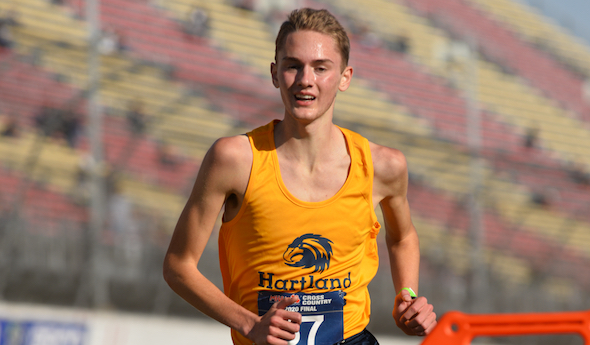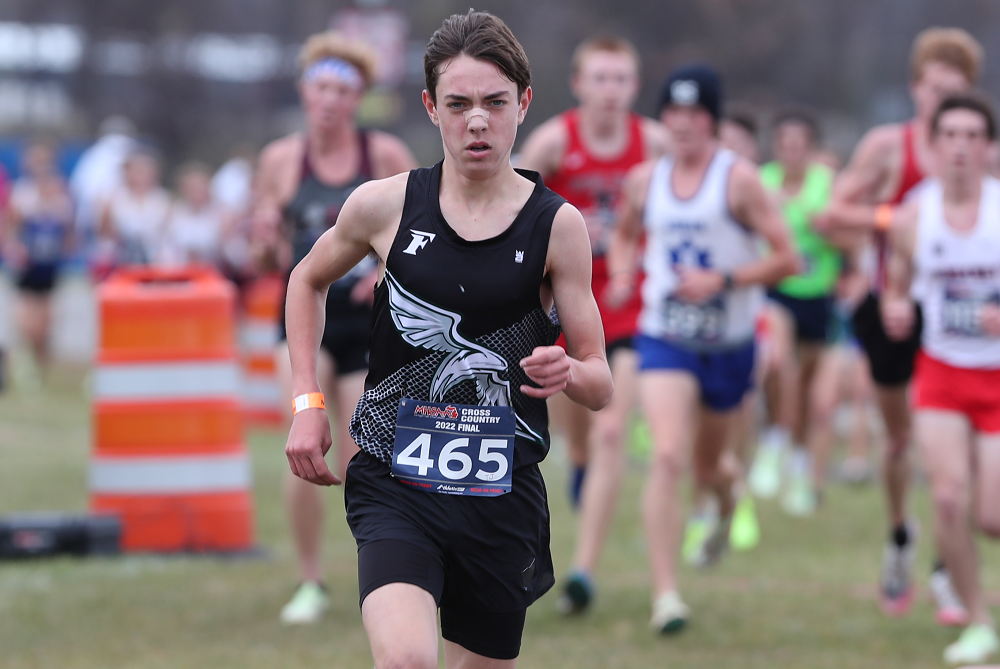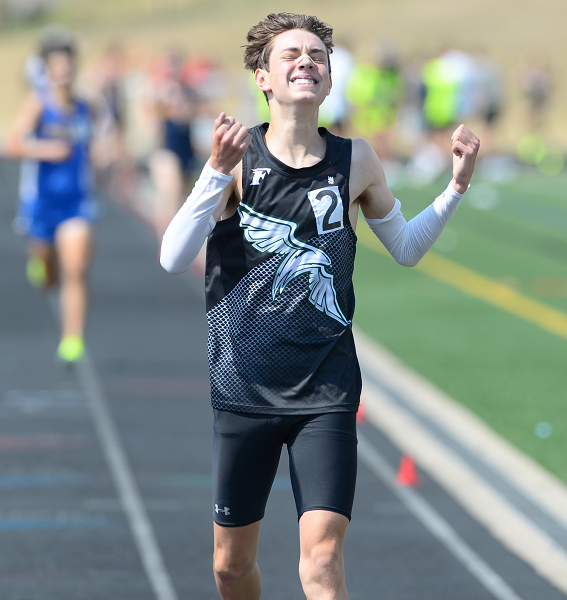
Hough, Kessler, Romeo Show Speed
November 6, 2020
BROOKLYN — Junior Riley Hough of Hartland and senior Hobbs Kessler of Ann Arbor Skyline would have preferred settling it head-to-head, not in a glorified time trial.
But both also understood the unique circumstances presented by the COVID-19 pandemic and appreciated any opportunity to compete in an MHSAA cross country championship.
Kessler ran the third-fastest time in the 25-year history of cross country Finals at Michigan International Speedway in the first of two Division 1 boys heats, only to be edged by a slightly greater performance by Hough in the second heat Friday morning.
Hough started and finished strong, overcoming Kessler’s faster third mile, to win the championship with a time of 14 minutes, 49.62 seconds. It was a the second-fastest time in MIS history, trailing only the legendary 14:10.4 performance by three-time Olympian Dathan Ritzenhein of Rockford in 2000.
Kessler raised the bar for Hough, posting a time of 14:51.79 in the first heat.
“I’m proud, because that was 100 percent of what I could give, but I can’t control anything he does,” Kessler said before Hough took the course. “I’m inclined to think he’s going to do great. He’s super talented and tough.
“It’s not the way I would’ve liked it, but I can’t complain too much. I did not think there was going to be a state meet. It was more of a gift. You can complain about the format, but it still resembles a state meet pretty similarly. It’s a blessing we got something in.”
Kessler was in the first heat because he was an individual qualifier. The first heat had individual qualifiers and third-place teams from Regionals. The second heat had first- and second-place teams from Regionals, a move designed to limit the size of fields to be in compliance with COVID-19 guidelines.
Hough and Kessler met during a dual meet Aug. 25, with Kessler pulling away in the final half mile for the victory.
Hough’s coaches let him know the time he had to beat while he was completing his warmup.
 “That’s definitely weird having the state meet sound like a time trial,” said Hough, who was 27th as a freshman and seventh as a sophomore.
“That’s definitely weird having the state meet sound like a time trial,” said Hough, who was 27th as a freshman and seventh as a sophomore.
Hough’s coach, Matt Gutteridge, believes his runner can go down as one of the all-time best in a state that has produced great cross country talent.
“The sky is absolutely the limit,” Gutteridge said. “If he works hard and does all the right things and listens to myself and his dad, he can do whatever he wants.
“The thing that always comes back to MIS is what does the course look like? Hopefully he’s strong enough to run through any of the conditions that are out there. This is the girls’ side, but I remember Megan Goethals (of Rochester) running extraordinary on a really bad day. I think that’s something Riley’s going to be able to do next year. It doesn’t matter what the weather’s going to be, he’s strong enough to run away with it hopefully.”
Hough ran through two miles in 9:32.9, compared to 9:38.3 for Kessler. Kessler had a faster third mile, reaching that mark in 14:24.1 compared to 14:24.7 for Hough.
Hough focused on the clock as he sprinted toward the finish line.
“That last straightaway, my coaches were yelling at me to go,” Hough said. “I was telling me to go. I was basically dead, but I knew I had to push it beyond my limit. It worked out in the long run.”
Romeo, ranked No. 1 all season, backed it up on the course by winning the team championship with 124 points. Caledonia was second with 156.
Zander Cobb was second among team runners in 15:32.33, Jack Kelke seventh in 15:41.94, Joseph Rinke 22nd in 16:12.56, Owen Sharnas 25th in 16:18.55 and Jack Wallace 38th in 16:29.24 to lead Romeo.
PHOTOS: (Top) Hartland’s Riley Hough charges toward the finish at MIS on Friday on the way to the second-fastest time of an MHSAA Finals at the track. (Middle) Romeo’s Jack Wallace (148) leads another group down the stretch in helping his team to the championship. (Click for more from RunMichigan.com.)

Freeland's Hansen Not Focused on Joining All-Time Greats - But On His Way
By
Paul Costanzo
Special for MHSAA.com
September 29, 2023
The goal written on Matt Kaczor’s Post-It Note was sub-15 minutes, 15 seconds. That’s what the Freeland cross country coach was hoping for from star runner TJ Hansen during his junior season.
 Kaczor tore it up after seeing Hansen run a single race this fall.
Kaczor tore it up after seeing Hansen run a single race this fall.
“Knowing what he did over the summer and where he was at, seeing what his 1,600 (meter) and his mile got down to, I had a feeling he could get under 15:30 quickly,” Kaczor said. “After the first race, I looked at my assistant and was like, ‘I’ve gotta rip up that Post-It Note. I don’t think our goal is on the level of where he’s at right now.’ At first, it was break 15:15. Once I saw him race at the Under the Lights (on Aug. 18 at St. Johns), I was like, ‘Yeah, he’s going sub 15.’”
Hansen ran 15:39.6 in that first race, and on Sept. 7, in Shepherd, he ran 15:13.9 to meet the goal written on the now-shredded Post-It Note.
This past Saturday, he ran 15:03.7 at the Cadillac Veterans Serving Veterans Invitational. It’s the fastest time recorded in Michigan this year, and a signal that Kaczor might be filling out a new Post-It Note before the season is out.
“The sub-15 barrier, that’s been something on my mind for a while,” Hansen said. “Now that I’m edging closer and closer to that, it’s been exciting. With how heavy my training has been, I wouldn’t expect (to have run this fast this early). Being able to run the times I am really paints the picture for what’s ahead.”
Hansen came into the season already regarded as one of the elite distance runners in the state. He won the 3,200 meters at the MHSAA Lower Peninsula Division 2 Track & Field Finals this past spring. He’s also finished all-state (12th and fifth, respectively) the past two seasons at the LPD2 Cross Country Finals.
His current trajectory, however, would put his name near some of the state’s all-time greats. But that’s not something Hansen is focusing on.
“I really don’t like to compare myself to others,” he said. “I don’t focus on that. I try to be the best TJ Hansen that I can be. The best version of myself.”
Focusing on himself is almost necessary for Hansen, as he’s spending a lot of time during his races running by himself.
At each of the big events Freeland has run in this season, Hansen has finished at least 20 seconds ahead of his nearest competitor. That includes all divisions of the Duane Raffin Festival of Races in Holly.
In Cadillac, where Hansen ran his current best time, he was a full minute ahead of the rest of the field.
 “He’s just a special athlete,” Kaczor said. “I can’t see Freeland having someone like this in a while. He’s a generational talent. What’s crazy is, I had the school record when he was a freshman. He and Braden (Honsinger) broke it last year. But TJ has now dropped that school record (set in 1998) by almost a minute.”
“He’s just a special athlete,” Kaczor said. “I can’t see Freeland having someone like this in a while. He’s a generational talent. What’s crazy is, I had the school record when he was a freshman. He and Braden (Honsinger) broke it last year. But TJ has now dropped that school record (set in 1998) by almost a minute.”
Hansen’s achievements have already put him on a path to run at the next level, which is something of a family tradition.
His older sisters Peyton and Kiera are track & field athletes at Wayne State and Eastern Michigan, respectively. Their parents, Tim and Pam, were track & field stars at Central Michigan.
TJ has drawn the attention of coaches around the country, including from Michigan, Michigan State, Wisconsin, Tennessee and Colorado.
Having family members who know the process is a help for Hansen, and he said they’ve all been good about allowing him to choose his own path, whatever that may be.
“He’s from a good family that knows how to work and knows how to get things done,” Kaczor said. “He knows that if he puts in the work, he’s going to be at a good spot.”
While Hansen admits it can be a bit overwhelming, he’s using it as motivation to run faster and continue to put his name out there.
Also serving as motivation is 2022 Division 2 champion Connell Alford of Chelsea. Alford is among the elite group of runners in Michigan who have broken the 15-minute mark, doing it twice a year ago.
He currently has the state’s second-best time behind Hansen’s this year, running 15:09.1 at the MSU Invitational on Sept. 15.
“Whenever I see him drop a time, my main goal is to run faster,” Hansen said. “Whenever I see him run a good time, that motivates me to work hard.”
The two won’t see each other until the MHSAA Finals on Nov. 4 at Michigan International Speedway. It’s an opportunity Hansen is excited for, as it’s a chance to race and be pushed toward the lofty goals he’s set for himself. Kaczor is excited about it, too, even if it might mean having to replenish his supply of Post-Its.
“We don’t talk about winning the state title; we talk about making sure that we have great races on those days,” Kaczor said. “We can’t control how somebody else runs. It’s a matter of can we, if the weather is right and the course is in good condition, can we be one of the few guys that has run in the 14s on that course? That’s the goal. Put yourself in some great categories with those upper echelons and the greats of all-time.”
 Paul Costanzo served as a sportswriter at The Port Huron Times Herald from 2006-15, including three years as lead sportswriter, and prior to that as sports editor at the Hillsdale Daily News from 2005-06. He can be reached at [email protected] with story ideas for Genesee, Lapeer, St. Clair, Sanilac, Huron, Tuscola, Saginaw, Bay, Arenac, Midland and Gladwin counties.
Paul Costanzo served as a sportswriter at The Port Huron Times Herald from 2006-15, including three years as lead sportswriter, and prior to that as sports editor at the Hillsdale Daily News from 2005-06. He can be reached at [email protected] with story ideas for Genesee, Lapeer, St. Clair, Sanilac, Huron, Tuscola, Saginaw, Bay, Arenac, Midland and Gladwin counties.
PHOTOS (Top) Freeland's TJ Hansen leads a pack during last season's LPD2 Final at Michigan International Speedway. (Middle) Hansen enjoys a moment of exhilaration after winning the 3,200 this spring at the LPD2 Finals at Ada Forest Hills Eastern. (Top photo by Carter Sherline/Run Michigan; middle photo by Dave McCauley/Run Michigan.)

